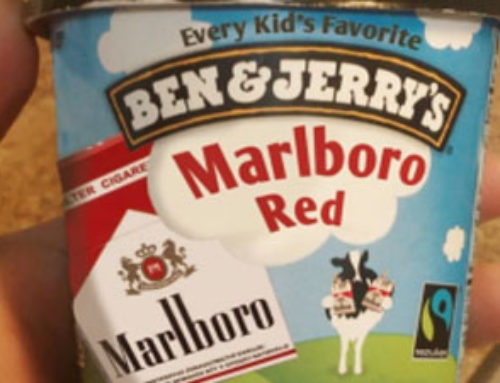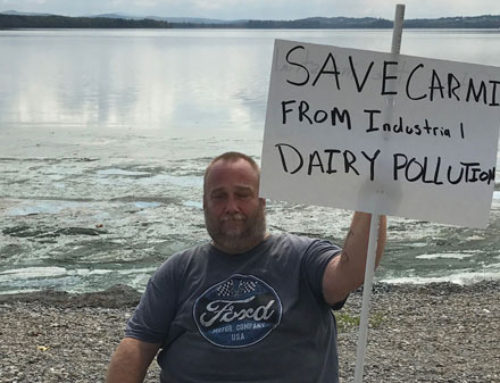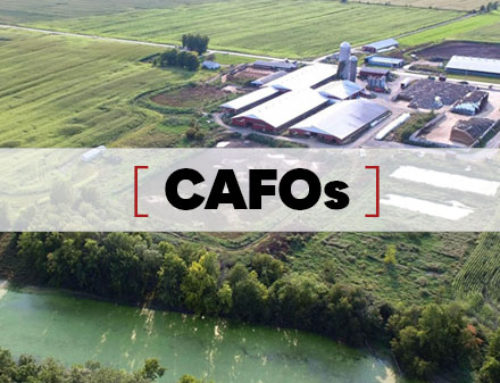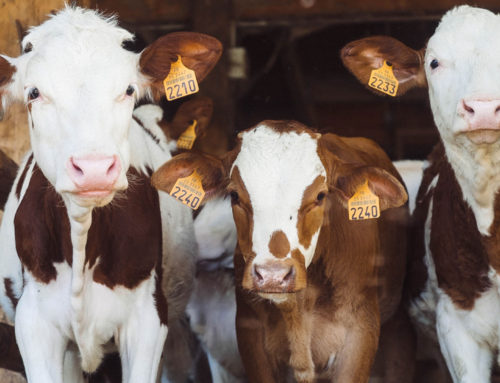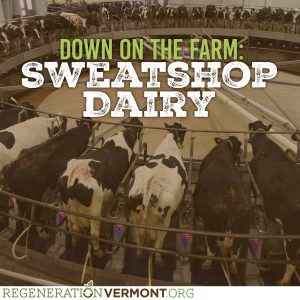 These are harrowing times for the nearly 1,500 migrant workers laboring on Vermont’s largest dairy farms. These farmworkers, predominantly from Mexico, are forced to live in the shadows, where their farm bosses harbor them in exchange for long hours, low wages, and cheap housing. It’s a human rights stain on the state, allowing these migrant workers to live and be treated this way. And it continues because there’s a whole lot of “looking away” from the deep-rooted ugliness of this system, which has been described by human rights advocates as “close to slavery.”
These are harrowing times for the nearly 1,500 migrant workers laboring on Vermont’s largest dairy farms. These farmworkers, predominantly from Mexico, are forced to live in the shadows, where their farm bosses harbor them in exchange for long hours, low wages, and cheap housing. It’s a human rights stain on the state, allowing these migrant workers to live and be treated this way. And it continues because there’s a whole lot of “looking away” from the deep-rooted ugliness of this system, which has been described by human rights advocates as “close to slavery.”
Worse than looking away, with its implicit acceptance of the exploitation, is the complicit role Vermont’s dairy industry giants are playing to maximize their profits on the backs of this cheap labor. As the state’s near-billion-dollar-a-year ice cream and cheese corporations – Ben & Jerry’s and Cabot Creamery – continue to pay less than the cost of production for its dairy supply, Vermont’s remaining 700-or-so dairy farms are forced to cut costs at every opportunity, particularly when it comes to labor. Gone are the days when these farm jobs were filled by neighbors and community members, as the danger, speed, scale and filth – coupled with poverty-level wages — has made it impossible to attract local workers.
But Ben & Jerry’s took its complicity in the migrant worker exploitation to a whole new level of cruel and delusional recently when, in what can only be called a publicity stunt, corporate officials announced that its “Milk with Dignity” program was successfully addressing the migrant labor problem. At a hastily called press conference just days after the ice cream giant was stung by a consumer deception lawsuit by the Organic Consumer Association, claiming its health and environmental claims were fraudulent, Ben & Jerry’s revved up its public relations machine and, in search of some positive marketing spin, declared themselves to be “succeeding” in addressing the migrant labor issue.
Missing from the event, however, were any actual farmworkers to attest to Ben & Jerry’s cynical spin. The one farmworker who was scheduled to appear did not show up, creating a rather awkward moment when it was announced he “couldn’t get off his milking shift.” Sadly, it was a very believable excuse, as research shows that Vermont’s migrant dairy workers are putting in close to 80 hours a week. There was no similar attendance problem for the six-figure-salaried Ben & Jerry’s executives and their bevy of assistants, who showed up en mass to tell the media just how wonderful things were for the 250 farmworkers in its program, regardless of the fact that not one of them could get time off to be there.
Of course, it’s about more than just getting time off. There is a very real – and understandable — fear within the migrant community about leaving the farm. Unlike other migrant farmworkers, those laboring in the dairy industry have no rights or legal standing because their work is considered permanent, not seasonal like the work associated with fruit or vegetable production, where farmworkers get temporary H-2 visas.
There are no such visas available for dairy workers. They are defined as “illegal” by the federal government, leaving them in constant jeopardy of arrest and deportation. And it’s worse in the current political climate, where increasingly aggressive ICE tactics become the norm, leaving them vulnerable at all times, even while doing the most mundane daily tasks like going to the store, visiting the doctor, or simply driving our roadways. It is no way to live in the land of the free.
Besides, the last time migrant farmworkers appeared publicly at Ben & Jerry’s Waterbury, Vermont headquarters, two were arrested by ICE agents on their way home, beginning a long legal ordeal they eventually won with enormous community support, but not after extended incarceration and weeks of lost wages. Those arrests occurred last summer, 2017, when the farmworkers were marching on Ben & Jerry’s to contrast their abysmal conditions and pay with the corporation’s exploding profits, growing at more than $100 million a year, and to demonstrate their frustration over the three-year stall that was happening with the Milk with Dignity negotiations. [Disclaimer: I marched with them.]
Those profiting from this exploited labor, the large dairy farmers and the dairy buyers like Ben & Jerry’s, don’t share in any of the legal risks born by the workers. They don’t fear arrests for their role in the “illegal” nature of the arrangement, and they remain fully insulated from the near-constant worries about being caught. It is a pure and blatant show of privilege, for sure.
But it’s within this reality – this core of exploitation — that Ben & Jerry’s would now like the public to believe that progress is being made for these farmworkers. They point to the Milk with Dignity agreement they finally signed last year in partnership with Migrant Justice, a Vermont-based nonprofit that campaigns for the rights of migrant workers. While negotiating the “Code of Conduct” that was more than three years in the making, the Ben & Jerry’s Foundation was a major funder of its negotiating partners, Migrant Justice. Foundation records show that they gave the nonprofit at least $75,000 during negotiations.
They were together again at the press event in July to applaud their farmworker “progress.” It came with the typical Ben & Jerry’s hype and circumstance. They spoke, for example, about the 72 farms that had signed up for the program, where roughly 250 migrant workers are employed, representing just 17% of the state’s total migrant workforce.
But what they didn’t tell the people gathering for the publicity stunt was that there’s no connection between signing up for the program and adhering to the program’s Code of Conduct, the nitty-gritty of the agreement that outlines the farmworker protections. Among the most touted aspects of the Code are a “right” to the prevailing minimum wage (current $10.50/hour), one day off a week, 8 hours off per 24 hours of work, a real bed – not straw piles, and running water.
“Compliance with the Code of Conduct is the goal,” reported Will Lambek of Migrant Justice, in an interview with Regeneration Vermont after the press event.
And when asked how many of the 72 farms that have signed up for the program are in compliance, Lambek replied: “Zero.”
Unfortunately, that bit of truth didn’t make it into the fawning media coverage the well-orchestrated press event received, including a short New York Times piece that was headlined, “Farm Worker Program a Success.” It was the kind of coverage that must have had them dancing in the corporate headquarters of Unilever, the European mega-corporation that owns the Ben & Jerry’s brand, among dozens of others, where market share – not social justice – is the primary goal. Unilever has called for Ben & Jerry’s to be among its billion-dollar-a-year-brands by 2020.
The media coverage also dutifully reported on Ben & Jerry’s assertions of a “third party” that was set up to monitor and enforce the “improvements” for the farmworkers, the Milk with Dignity Standards Council. Not disclosed, however, was the close financial relationship between the ice cream corporation and this “third party.”
“Ben & Jerry’s provided the initial financial support to the Council,” said Rob Michalak, Ben & Jerry’s Director of Social Impact, in an interview with Regeneration Vermont. And, according to Michalak and Lambek, most of the Council’s enforcement and compliance efforts continue to be funded by Ben & Jerry’s, via premiums paid to farms that sign up for the program.
Regeneration Vermont asked for the details on these premiums, including total amounts paid out this year, the average per farm, and specifics about how these premiums were improving the conditions and salaries of the farmworkers.
“We don’t make that public,” replied Ben & Jerry’s Michalak.
“We’re not disclosing that,” offered Migrant Justice’s Lambek. “There’s a dearth of specifics.”
But Lambek did point to the “testimonials page” of his group’s website, where evidence of the program’s success could be found, he claimed. The testimonials, however, only prove the voluntary nature of the Code of Conduct, as one featured farmworker, identified only as “David,” underscoring the fear of even being able to use their own names in relation to this “successful” program, declared that “now I have two full days off a month.” The Code of Conduct calls for at least four days off a month. But it’s just a goal, with “success” being a moving target, as long as it’s subservient to Ben & Jerry’s marketing and sales, apparently.
Finally, there was much fanfare about the “hotline” that the Milk with Dignity program set up for farmworkers to call if they had complaints about their working conditions, treatment or even pay. It was reported that several dozen calls had already been made to the hotline. But, once again, the nature of these calls and, more importantly, the results were “not being made public,” according to Lambek.
Which brings us to what is perhaps the biggest loophole in the program, the annual nature of the farms’ commitment to it. Each year, every one of the current 72 farms has the right to simply opt out of the program, with no consequences other than no longer being eligible for the secret premiums. So if — or when — the Ben & Jerry’s-funded Standards Council starts to really make demands on these farms, or decides to enforce compliance with things like earning a minimum wage or not having a pile of straw be called a bed, these farms can simply walk away, thus arguably leaving the farmworkers at these farms even more vulnerable, not just to the conditions and treatment but also to potential retaliation.
And how would Ben & Jerry’s respond to this? “Our goal is to have enough farms signed up to cover our dairy purchasing universe,” reported Ben & Jerry’s Michalek. “So if farms left the program, we’d have to find replacements.”
In other words, Ben & Jerry’s just wants enough farms signed up for its Milk with Dignity program every year so that they can say the amount of milk produced by these farms is roughly the same as the amount of milk they purchase, regardless of the farms’ long-term commitment to the program.
Those 72 farms exist within the universe of the more than 300 farms that ship milk to Ben & Jerry’s dairy supplier, the St. Albans Cooperative Creamery. Since none of the milk from these 72 farms is segregated for the exclusive use for Ben & Jerry’s and its products, it wouldn’t be hard for farm replacements to be found amongst the other 230 farms not currently in the program, thus beginning – again – the road to compliance. Until, that is, they, too, might find it too burdensome, potentially creating a revolving door of farm participation in the program, keeping it alive for public relations purposes but leaving the farmworkers unprotected.
It’s this lack of segregation of Ben & Jerry’s dairy supply that is central to the “deceptive labeling and marketing” lawsuit filed against the corporation earlier this summer by OCA. Those 72 farms are also considered to be part of yet another publicity stunt by Ben & Jerry’s, known as its “Caring Dairy” program, which makes claims about pesticide use, water quality and animal welfare on those farms. But, again, the program is voluntary, policed by those funded by Ben & Jerry’s, and none of the milk from these supposedly “caring” dairies is dedicated to the Ben & Jerry’s product line. It’s just marketing, and, as OCA asserts, “deceptive marketing,” because not only do most of these “caring” farms still use pesticides, antibiotics, GMO feed corn, and full-time cow confinement, none of them have a direct and verifiable relationship to what’s in Ben & Jerry’s ice cream. The milk they produce might be in that pint of ice cream, or, more likely given the odds, it might not. But the public relations show must go on.
Unfortunately, these kinds of marketing gimmicks are nothing new to Ben & Jerry’s. We all remember, for example, how they were going to “save the Rainforest” with a mere flavor, or that the wars of the world would be ended with its “1% for Peace” donations. And with each gimmick, the public relations game is the same: Quick and easy publicity to boost sales and then move on to the next, great claim.
But these kinds of marketing games cross a line when it comes to farmworkers and basic human rights and dignity. These are truly scary times for the migrant workers on the farms that supply Ben & Jerry’s, where they live in abject fear of arrest and deportation – 24 hours a day, including the 8 of which Ben & Jerry’s “hopes” to let them have off. They have no legal standing or rights, with or without a “Milk with Dignity” program.
Worse, the false publicity generated from its Milk with Dignity program creates the impression that progress is being made for these still-exploited farmworkers. It’s still a migrant worker scenario that is “close to slavery,” which, at best, is made a little bit better if you trust the unverified claims. But where is the dignity in a system that’s just a little bit better than close to slavery?
In the end, as is always the case with these publicity stunts, there’s only one, verifiable place where progress is made: Ben & Jerry’s rising sales and the growing profits shipped off to its parent corporation, Unilever.
To which, we say: No justice, no ice cream.
— Michael Colby
